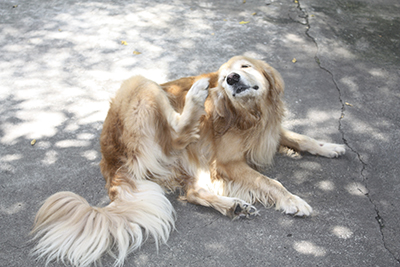Fleas are nuisance pests, parasites really, that feed on humans and other warm-blooded animals. In general when you have a flea problem, you and your pest serve as the host. Unfortunately, due to the flea life cycle and feeding habits it’s often hard to realize you have an infestation until you’ve been away from your home for a bit. Oddly enough, fleas get hungry while the hosts are away and become very active when the host returns. It’s often the time when you can spot an infestation. Putting your furry friend outside will not solve the problem as it only makes fleas turn towards the humans in the household to feed.
Fleas: Identify and Manage
Fleas are relatively easy to see in their adult state. Flea eggs, larvae and pupae are more challenging to identify. They are often found in places that are difficult to see behind, under or in furniture, pet bedding, cracks and grooves in the floors and in carpets. Flea eggs deposited by the adult female fall off your pets and as they move, your furry friend can disburse them throughout the house. Flea eggs represent one-half of the entire flea population in an average home and will eventually turn into larvae. When conditions are favorable the larvae will pupate, emerge as adults, and start feeding on the host.
Signs of Fleas
A good indicator that fleas are bothering your pets are if they repeatedly scratch and groom themselves. Humans may experience bites that leave behind itchy bite marks. So you’ve spotted them on your pets and in your house, now what?
Fleas In The House
Fleas depend on a blood meal from a host to survive. The most effective way to keep fleas from getting inside the home is to routinely examine your pets for adult fleas. Using veterinarian-approved flea control products on pets can keep an outbreak from happening.
Flea Treatment and Prevention
Since the immature stages of fleas are difficult to detect, the first thing the homeowner should do is contact a pest control specialist for assistance. We’re happy to assess and treat.
In most cases of an intense outbreak, using over-the-counter products for controlling fleas will not give you long-term results. We’re able to inspect and locate where the eggs and early stage flea populations reside and develop a treatment and prevention plan.
This plan includes:
- Identifying the areas of infestation.
- Inspecting for the presence of other animals that are the flea population’s source of food. This may include rodents either inside or outside the home or perhaps a raccoon or feral cat that is living in a crawl space.
- Suggesting that the homeowner contact their veterinarian for advice and purchase of flea control products that can be used on pets.
- Explaining the use of growth regulators that will interfere with the flea’s normal development into the adult stage.
- Recommending daily vacuuming after treatment to stimulate pupae.
- Treating affected areas by using safe and effective flea control products where immature fleas may be located.
- Scheduling a follow-up visit.


